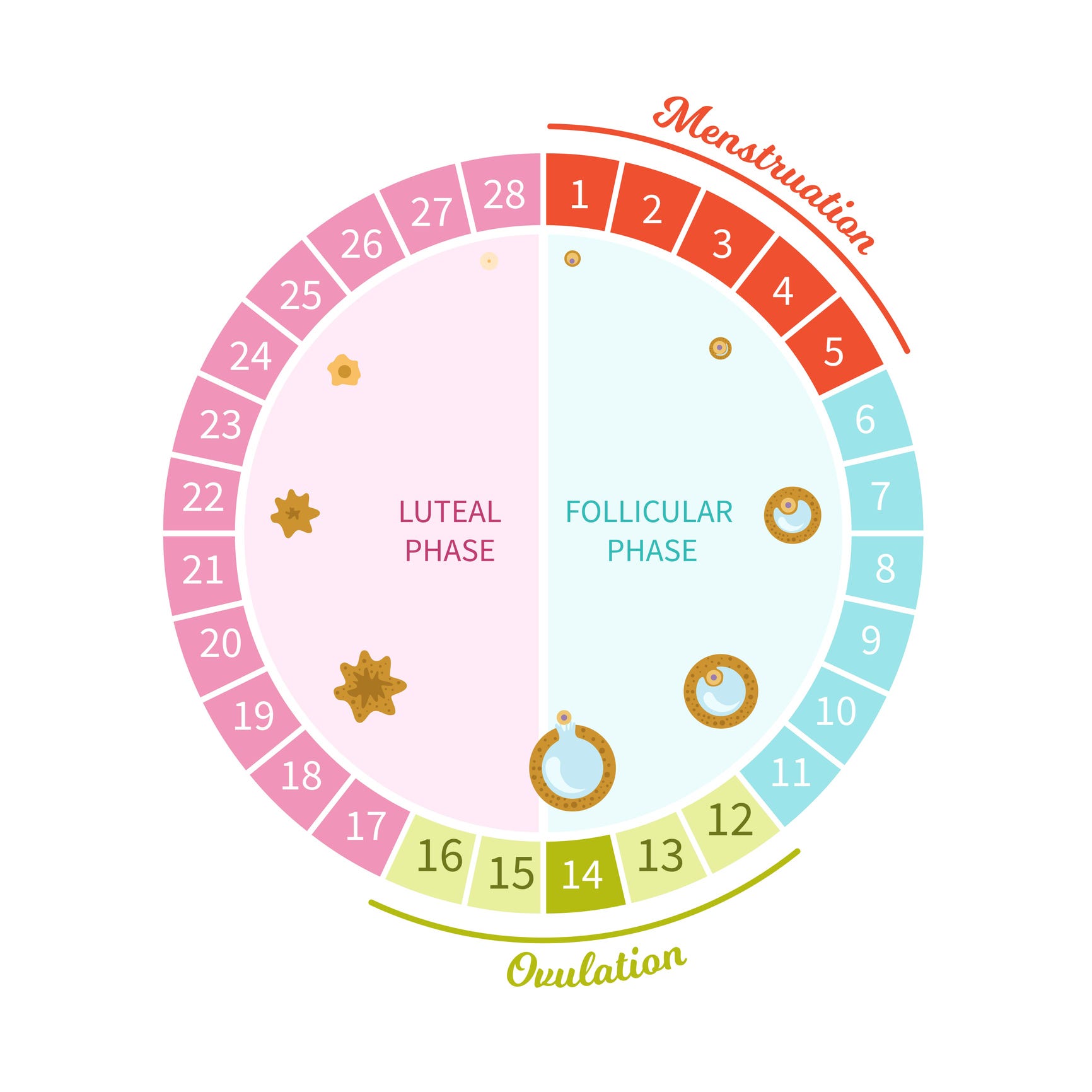
grinvalds/Getty Images
- The menstrual cycle has four phases: menstrual, follicular, ovulation, and luteal.
- The main purpose of the menstrual cycle is to produce an egg for potential fertilization by sperm.
- Stress, certain medications like birth control, polyps, fibroids, and more can disrupt the cycle.
- Visit Insider's Health Reference library for more advice.
While your period is often viewed as the main event of your menstrual cycle, there's much more going on in your body that you may not think about.
The menstrual cycle is what allows you to eventually become pregnant. That's why people with vaginas typically have a menstrual cycle during the age that their bodies are most capable of carrying a fetus to term, starting around age 12 or 13 and continue through their 40s or 50s.
The average duration of a menstrual cycle is 28 days, but it varies person to person. If you're not pregnant, you'll go through four main phases or events. Here's a visual of how those phases overlap:

1. The menstrual phase
The menstrual phase is the first phase of the menstrual cycle and lasts about seven days – you may know it as your period.
During the menstrual phase, your hormones shift: Estrogen and progesterone drop and your body releases prostaglandins, another type of hormone.
Estrogen and progesterone cause the lining of your uterus to shed - and this fluid is what you bleed out when you have your period. The uterus sheds its lining because it's not necessary when there is no embryo to support, says Sophia Yen, MD, MPH, reproductive health expert and the co-founder and CEO of women's telehealth provider Pandia Health.
Some people will bleed for only three days, while others will bleed for a week or longer, says Yen.
Aside from bleeding, you may experience other symptoms during your period such as:
- Cramps
- Bloating
- Tender breasts
- Acne breakouts
- Mood changes
2. Follicular phase
The follicular phase overlaps with menstruation, since it begins on the first day of your period, and lasts between 10 to 16 days.
During this phase, your body releases Follicle-Stimulating Hormone (FSH). This triggers your ovaries to create follicles, which are sacs containing immature eggs.
Yen says around 10 follicles will grow and compete to "win." The follicle that is the strongest will get to grow and eventually contain a mature egg capable of fertilization. Your body will reabsorb the other follicles.
Since the follicular phase overlaps with menstruation, the symptoms you experience around this time, such as cramps and bloating, are related to your period and not the follicles growing.
3. Ovulation
Ovulation happens around day 14 of your cycle, or about a week after the last day of your period, says Yen.
The "winning" follicle from the follicular phase grows into a mature egg that gets released during ovulation. The egg will travel from the ovary down into the fallopian tube, where it can potentially be fertilized by sperm.
Ovulation lasts for as long as the released egg is alive - typically 12-24 hours. However, it's important to note that there is a 3-to-5-day window around ovulation where you're most likely to get pregnant. That's because sperm can live inside your body for up to five days, waiting around for a mature egg to pass by.
During ovulation, you may experience changes such as:
- Clear, slippery discharge similar to a raw egg white, says Yen.
- Mittelschmerz, or pain on one side depending on which ovary releases the egg. The pain can be dull, achy, or sharp.
- Increased libido
4. Luteal phase
The luteal phase is the last phase of the menstrual cycle, and it typically goes for 14 days.
During this time, Yen says the remainder of the dominant follicle turns into the corpus luteum, which is essentially a mass of cells which makes the hormone progesterone. This thickens the uterine lining, preparing the body pregnancy if the egg should be fertilized.
Since this phase leads up to your period, you may experience symptoms of premenstrual syndrome (PMS) around day 12 of the luteal phase, such as:
- Cramps
- Fatigue
- Mood changes
- Headaches
- Bloating
- Bowel movement changes
- Difficulty sleeping
What could disrupt the menstrual cycle?
Irregular menstrual cycles are one of the most common gynecological concerns, says Jerome Chelliah, MD, MPH an OB-GYN at Cleveland Clinic and women's health educator. He says there are many possible causes for disrupted menstrual cycles, including:
- Stress: The exact reason why stress can throw off your cycle is unknown, Chelliah says, but it may be because stress causes the release of cortisol (the stress hormone) which can trigger an overall hormonal change that disrupts your period.
- Medications or birth control: Medications, even if they aren't directly related to your reproductive system, can cause irregular periods. For example, Chelliah says psychiatric medications, blood thinners, and steroids may affect your hormones and disrupt your cycle. Additionally, birth control such as IUDs may cause cycle irregularities, especially at first.
- Ovulatory dysfunction: This is when your period is irregular due to lack of ovulation or irregular patterns of ovulation. "As ovulation is a key marker for hormonal changes that happen during a cycle resulting in the eventual menses [aka bleeding], abnormalities in ovulation can cause abnormal periods," says Chelliah.
- Uterine polyps: Polyps are growths in the uterus that are typically benign, meaning non cancerous. Chelliah says they may cause prolonged periods or spotting in between periods.
- Uterine Fibroids: Fibroids are also typically benign growths in the uterus. They can cause you to have heavy menstrual bleeding and periods that last longer than a week.
Insider's takeaway
While the general 4-step process of the menstrual cycle is the same for everyone, every individual's cycle is unique.
If your periods suddenly become irregular or if you're experiencing new symptoms such as extra heavy or long periods, be sure to see your OB-GYN to get checked out.
